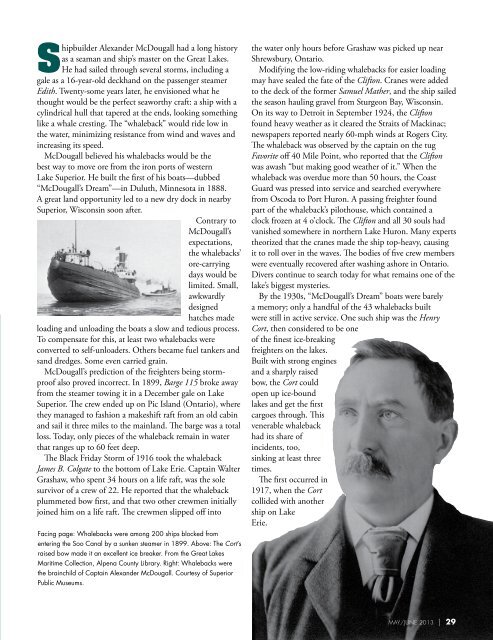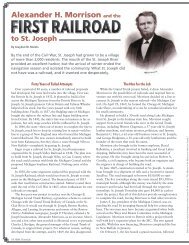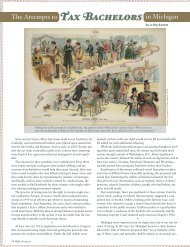The whaleback's profile was considered âgrotesqueâ by some ...
The whaleback's profile was considered âgrotesqueâ by some ...
The whaleback's profile was considered âgrotesqueâ by some ...
You also want an ePaper? Increase the reach of your titles
YUMPU automatically turns print PDFs into web optimized ePapers that Google loves.
Shipbuilder Alexander McDougall had a long history<br />
as a seaman and ship’s master on the Great Lakes.<br />
He had sailed through several storms, including a<br />
gale as a 16-year-old deckhand on the passenger steamer<br />
Edith. Twenty-<strong>some</strong> years later, he envisioned what he<br />
thought would be the perfect seaworthy craft: a ship with a<br />
cylindrical hull that tapered at the ends, looking <strong>some</strong>thing<br />
like a whale cresting. <strong>The</strong> “whaleback” would ride low in<br />
the water, minimizing resistance from wind and waves and<br />
increasing its speed.<br />
McDougall believed his whalebacks would be the<br />
best way to move ore from the iron ports of western<br />
Lake Superior. He built the first of his boats—dubbed<br />
“McDougall’s Dream”—in Duluth, Minnesota in 1888.<br />
A great land opportunity led to a new dry dock in near<strong>by</strong><br />
Superior, Wisconsin soon after.<br />
Contrary to<br />
McDougall’s<br />
expectations,<br />
the whalebacks’<br />
ore-carrying<br />
days would be<br />
limited. Small,<br />
awkwardly<br />
designed<br />
hatches made<br />
loading and unloading the boats a slow and tedious process.<br />
To compensate for this, at least two whalebacks were<br />
converted to self-unloaders. Others became fuel tankers and<br />
sand dredges. Some even carried grain.<br />
McDougall’s prediction of the freighters being stormproof<br />
also proved incorrect. In 1899, Barge 115 broke away<br />
from the steamer towing it in a December gale on Lake<br />
Superior. <strong>The</strong> crew ended up on Pic Island (Ontario), where<br />
they managed to fashion a makeshift raft from an old cabin<br />
and sail it three miles to the mainland. <strong>The</strong> barge <strong>was</strong> a total<br />
loss. Today, only pieces of the whaleback remain in water<br />
that ranges up to 60 feet deep.<br />
<strong>The</strong> Black Friday Storm of 1916 took the whaleback<br />
James B. Colgate to the bottom of Lake Erie. Captain Walter<br />
Grashaw, who spent 34 hours on a life raft, <strong>was</strong> the sole<br />
survivor of a crew of 22. He reported that the whaleback<br />
plummeted bow first, and that two other crewmen initially<br />
joined him on a life raft. <strong>The</strong> crewmen slipped off into<br />
Facing page: Whalebacks were among 200 ships blocked from<br />
entering the Soo Canal <strong>by</strong> a sunken steamer in 1899. Above: <strong>The</strong> Cort’s<br />
raised bow made it an excellent ice breaker. From the Great Lakes<br />
Maritime Collection, Alpena County Library. Right: Whalebacks were<br />
the brainchild of Captain Alexander McDougall. Courtesy of Superior<br />
Public Museums.<br />
the water only hours before Grashaw <strong>was</strong> picked up near<br />
Shrewsbury, Ontario.<br />
Modifying the low-riding whalebacks for easier loading<br />
may have sealed the fate of the Clifton. Cranes were added<br />
to the deck of the former Samuel Mather, and the ship sailed<br />
the season hauling gravel from Sturgeon Bay, Wisconsin.<br />
On its way to Detroit in September 1924, the Clifton<br />
found heavy weather as it cleared the Straits of Mackinac;<br />
newspapers reported nearly 60-mph winds at Rogers City.<br />
<strong>The</strong> whaleback <strong>was</strong> observed <strong>by</strong> the captain on the tug<br />
Favorite off 40 Mile Point, who reported that the Clifton<br />
<strong>was</strong> a<strong>was</strong>h “but making good weather of it.” When the<br />
whaleback <strong>was</strong> overdue more than 50 hours, the Coast<br />
Guard <strong>was</strong> pressed into service and searched everywhere<br />
from Oscoda to Port Huron. A passing freighter found<br />
part of the whaleback’s pilothouse, which contained a<br />
clock frozen at 4 o’clock. <strong>The</strong> Clifton and all 30 souls had<br />
vanished <strong>some</strong>where in northern Lake Huron. Many experts<br />
theorized that the cranes made the ship top-heavy, causing<br />
it to roll over in the waves. <strong>The</strong> bodies of five crew members<br />
were eventually recovered after <strong>was</strong>hing ashore in Ontario.<br />
Divers continue to search today for what remains one of the<br />
lake’s biggest mysteries.<br />
By the 1930s, “McDougall’s Dream” boats were barely<br />
a memory; only a handful of the 43 whalebacks built<br />
were still in active service. One such ship <strong>was</strong> the Henry<br />
Cort, then <strong>considered</strong> to be one<br />
of the finest ice-breaking<br />
freighters on the lakes.<br />
Built with strong engines<br />
and a sharply raised<br />
bow, the Cort could<br />
open up ice-bound<br />
lakes and get the first<br />
cargoes through. This<br />
venerable whaleback<br />
had its share of<br />
incidents, too,<br />
sinking at least three<br />
times.<br />
<strong>The</strong> first occurred in<br />
1917, when the Cort<br />
collided with another<br />
ship on Lake<br />
Erie.<br />
MAY/JUNE 2013 | 29







